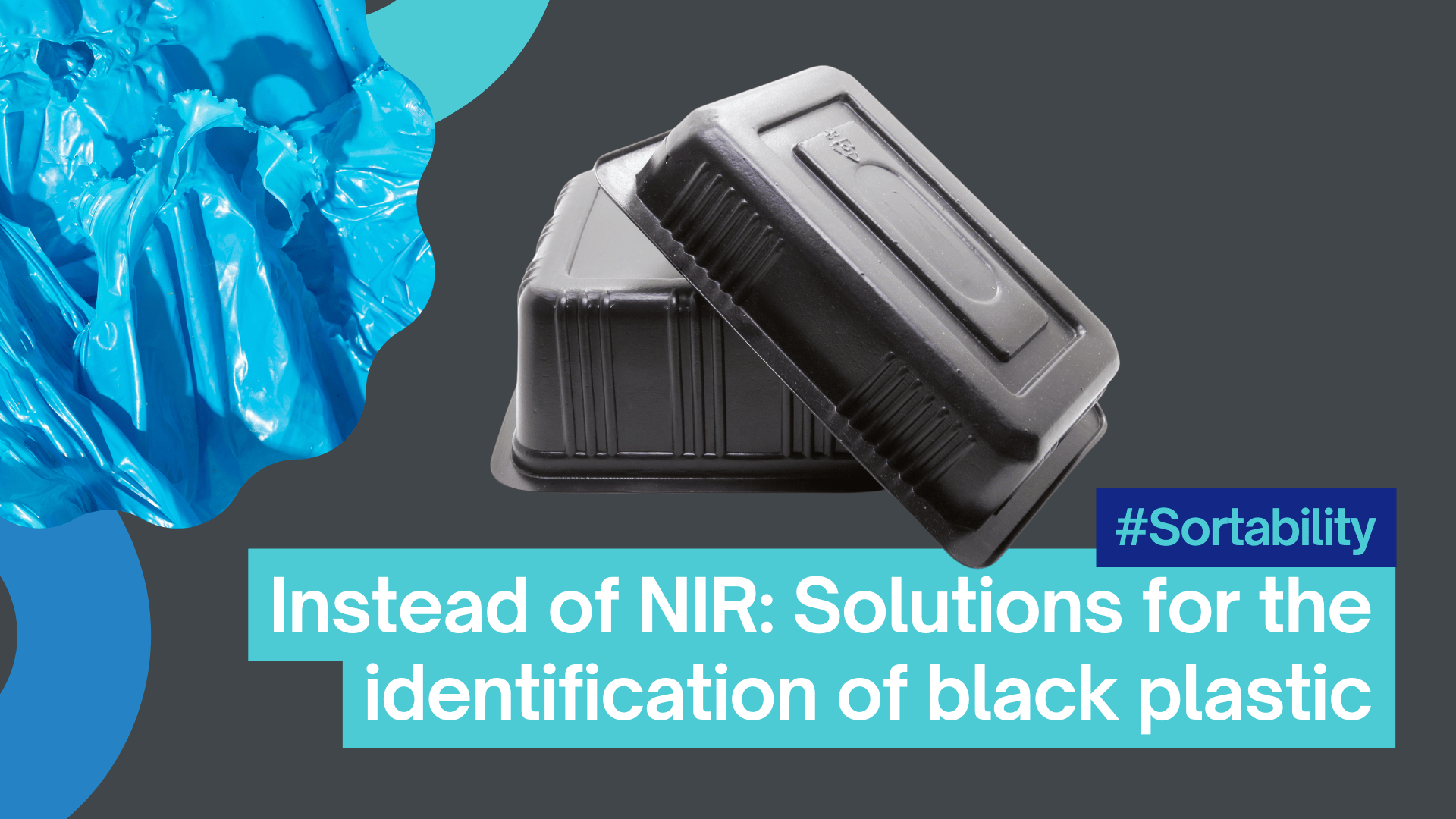Identifying Black Plastics: Why NIR Technology Fails and Alternative Solutions for the Recycling Industry
Identifying black plastics, particularly those filled with carbon black, remains a significant challenge in the plastics recycling industry. On the one hand, carbon black filled plastics are essential in many applications due to their unique properties. On the other hand, these same properties pose significant challenges for recycling. Despite the growing demand for recycled plastics, the presence of carbon black in these materials complicates the sorting process. Conventional near-infrared (NIR) spectroscopy, widely used in recycling facilities, struggles to accurately identify black plastics.
This article examines why NIR struggles with black plastics, outlines the market demand and regulatory drivers, and presents several alternative solutions to overcome this obstacle. We also introduce several commercially available products, compare their capabilities, and look at future trends in black plastic identification technology.
Why NIR Spectroscopy Fails with Black Plastics
NIR technology works by emitting infrared light and measuring how it reflects off materials. Different materials reflect light at different wavelengths, allowing the spectrometer to determine their composition. However, carbon black, a pigment not only used in black plastics, absorbs almost all NIR signal. This absorption prevents NIR spectrometers from capturing the necessary data to identify the plastic type, making the technology ineffective for black plastics.
The automotive and electronics industries, in particular, use black plastics extensively, making this a significant recycling challenge. With the rise of circular economy principles and increasing environmental awareness, there’s growing pressure to find alternative ways to sort black plastics effectively.
Market Demand and Economics of Black Plastic Recycling
Despite the difficulty in sorting black plastics, the demand for recycled plastics continues to grow. Industries are increasingly looking for sustainable materials due to environmental regulations, consumer pressure, and cost-saving initiatives. Black plastics are often found in durable goods, packaging, and various industrial applications, but the challenge in recycling them increases operational costs and impacts profitability.
As businesses adopt Extended Producer Responsibility (EPR) regulations and circular economy practices, finding efficient sorting technologies will be essential to capitalize on the growing market for recycled black plastics. Industries that heavily use black plastics will need to invest in technologies that meet both regulatory requirements and consumer expectations for sustainability.
Alternative Technologies for Black Plastic Identification
Several technologies have emerged as alternatives to NIR for the identification of black plastics, each with its advantages and limitations:
1. Mid-Infrared (MIR) Spectroscopy
- How it works: MIR spectroscopy uses a different portion of the infrared spectrum than NIR, allowing it to penetrate the surface and interact with the chemical bonds of the material. This makes MIR more effective at identifying materials, including some black plastics.
- Pros: Capable of identifying materials that absorb NIR, including many black plastics.
- Cons: More expensive and less portable than NIR-based systems. Requires specialized equipment and may have slower processing times.
- Products:
- Bruker ALPHA II FTIR system is a powerful MIR solution, offering detailed analysis and accurate identification. Pricing starts around €25,000, making it suitable for laboratories and industrial applications.
2. Raman Spectroscopy
- How it works: Raman spectroscopy identifies materials based on how they scatter light, rather than absorbing it. It is highly effective for analyzing black plastics, as the presence of carbon black does not interfere with its ability to detect chemical structures.
- Pros: Unaffected by carbon black, providing accurate results for black plastics.
- Cons: More expensive and slower than NIR; requires careful calibration and maintenance.
- Products:
- Bruker Raman Spectrometer: The BRAVO is a portable, easy-to-use Raman spectrometer designed for accurate material identification, including black plastics. Pricing typically starts around €30,000.
3. X-Ray Fluorescence (XRF)
- How it works: XRF technology uses X-rays to determine the elemental composition of a material. Since it works on a fundamental elemental level, carbon black does not affect its ability to identify black plastics.
- Pros: Can differentiate between a wide range of materials, including black plastics. Fast and accurate.
- Cons: Expensive and typically used for metals, limiting its broader use in plastics recycling.
- Products:
- Thermo Fisher Niton XL5: A high-end XRF analyzer suitable for large-scale recycling facilities. Prices typically start around €20,000.
4. Visual Sorting with AI and Machine Learning
- How it works: This method combines visual imaging technology with AI to “learn” the characteristics of black plastics. It sorts materials based on color, texture, and other visual data, making it a versatile solution.
- Pros: Fast and scalable, especially in large recycling plants. Continually improves through machine learning.
- Cons: Less effective with complex mixtures or when visual characteristics alone are insufficient.
- Products:
- Max AI offers an advanced system designed specifically for sorting black plastics. Max-AI uses AI-enhanced visual recognition and high-speed sorting to handle complex plastic waste streams. Pricing for large-scale installations typically starts at €300,000, depending on the facility size and throughput.
Future Trends in Black Plastic Sorting Technologies
The future of black plastic identification lies in the development of hybrid technologies that combine multiple methods to improve accuracy and speed. AI-driven innovations are expected to play a significant role in improving the efficiency of recycling facilities. These systems will leverage machine learning to handle more complex material streams, refining their identification processes over time.
Another promising trend is the exploration of new pigments for black plastics that are detectable by NIR systems. By changing the way these materials absorb light, manufacturers could eliminate the identification challenge altogether.
Conclusion: Choosing the Right Solution for Your Business
For businesses in the plastics recycling industry, black plastics represent a unique challenge. While NIR spectroscopy has limitations due to carbon black’s light absorption properties, several alternative technologies offer effective solutions, including MIR, Raman, and XRF. The choice of technology depends on the scale of your operations, budget, and specific material needs.
For smaller operations, portable solutions like the Mobile Bruker Raman Spectrometer Bravo offer flexibility. For large-scale recycling plants, systems like Max-AI provide advanced AI-driven sorting capabilities, while the Thermo Fisher Niton XL5 offers a robust XRF-based option.
The Black Plastic Dilemma
We’re often asked about alternatives to NIR for detecting black plastics. The truth is that while NIR spectrometers like the trinamiX NIR solution can’t identify black plastics, it remains your best option for most other materials. Its ease of use, portability and speed is a huge step forward for many organisations looking for solutions to streamline their processes and make material detection knowledge available to everyone, whether they work in QA, logistics, warehousing or purchasing.
This article was to explore why NIR is still the best starting point for recyclers and what options exist for black plastics. To learn more about these products, visit:
- Bruker ALPHA II FTIR: Bruker website
- Bruker BRAVO Raman Spectrometer: Bruker website
- Thermo Fisher Niton XL5: Thermo Fisher website
- Max-AI: Max-AI website
- trinamiX: portable NIR Scanner
About us – Solid Scanner
Let’s take responsibility and recycle more plastics, textiles, carpets, mattresses and more – ask us for suitable solutions. Our portfolio includes solutions ranging from small, portable solutions to individual solutions based on hyperspectral camera systems for simple, automated identification of plastics and in the sorting process and for inline process control, e.g. for homogeneity.
About trinamiX – the sensor technology company
Our technology partner trinamiX GmbH, based in Ludwigshafen, was founded in 2015 as a wholly owned subsidiary of BASF SE. As a start-up within the company, it is not only operationally independent, but also has unique access to the expertise and experience of the entire BASF Group. Its patent-pending technologies enable people and machines to capture the hidden and invisible world around them to make better decisions and increase safety.

